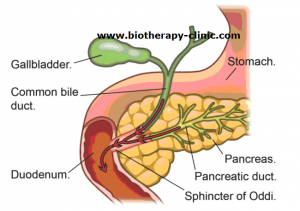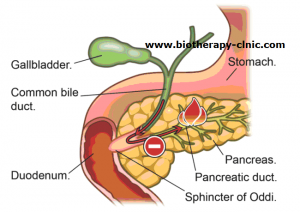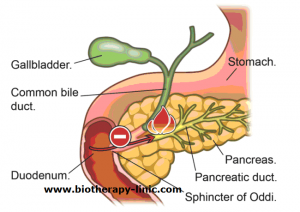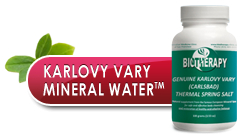For simplicity, imagine there are two rivers.
One river is large, clean, and clear and flows freely to the sea. It represents the pancreatic duct that moves the pancreatic juices with digestive enzymes into the duodenum. You may imagine the pancreatic digestive enzymes as the very explosive material in the inactive state. Before flowing into the sea (the duodenum), the first large, and clear river spills into a lagoon (the Ampulla of Vater). At the end of the entrance to the lagoon, there is a gate (the Sphincter of Oddi), which regulates the water coming into the sea (the duodenum).
The second river is smaller, with yellow, dirty, and greasy water, full of stones and debris. This second river is the bile duct that moves bile from the liver and gallbladder and merges with the first river near the gate of the lagoon. This gate is operated by an intelligent natural regulating system, which allows both rivers to mix and flow smoothly into the sea. This natural regulating system is a complex of the blood messengers-digestive hormones, which are produced in the duodenum and nervous branches surrounding this area.
If there is too much debris in the lagoon or the constant regulating system crashes and the gate is locked, it causes back up, flooding and many other problems. Rotting debris in the first river causes activation of the explosive matter such as the pancreatic digestive enzymes inside the pancreas. It creates damage of pancreas-pancreatitis. Back up of the second river (common bile duct) causes inflammation and a shutdown of the liver and the gallbladder.
This area is the key place where many liver, gallbladder, and pancreatic problems occur. Many scientists believe that the Sphincter of Oddi Dysfunction (SOD) is the cause of pancreatic diseases and that restoring proper function of this muscle valve is the correct way to heal congestion and inflammation of the pancreatic gland.
Recognizing the structure and function of the pancreas, liver, gallbladder, bile ducts, Sphincter of Oddi and duodenum may give the clue to natural healing actions for person with chronic pancreatitis.*
Let’s begin from the liver. The liver is body’s chemical factory, and it performs many vital tasks. The most significant function of the liver is to manufacture and release bile. The cells of the liver discharge bile into a network of the bile ducts. Like the rivers, these ducts gradually join to form one stream in the common bile duct, which exits (along with the pancreatic duct) into the duodenum-the first part of the small intestine.
The Sphincter of Oddi is the muscle valve surrounding the common bile duct and pancreatic duct in their way into the duodenum. If there is no food in the duodenum, a valve – the sphincter of Oddi remains closed, retaining the bile in the gallbladder and pancreatic juice in the pancreas. Spasm or blockage of this valve can cause bile and pancreatic juice to back up. Just remember, a tiny amount of bile in the pancreatic duct can cause serious trouble. Bile activates digestive enzymes inside the pancreas, and they start to digest their own pancreatic cells, causing pain, congestion, inflammation, even the death of pancreatic tissue.
Tumors, large gallstones and post-inflammatory scars that block the sphincter of Oddi indeed need surgery. There are not too many cases of individuals, which need operations, but millions of
Americans suffer from occasional, transient spasms of this sphincter with pain, nausea, gas and bloating. In most situations, their tests are normal and these individuals are labeled with acid reflux, IBS, stomach flu, food poisoning or other diseases. Many of these patients have type III Sphincter of Oddi Dysfunction (SOD). Lack of proper treatment of this condition can later cause serious complications like pancreatitis and gallbladder inflammation.
Sphincter of Oddi Dysfunction affects:
- Mostly adults after age forty
- More females than males
- Overweight individuals
- Populations post abdominal surgeries: for example, statistics shows that almost 20% of people after gallbladder removal have the Sphincter of Oddi Dysfunction.
Why does this muscle sphincter become spasmodic? It depends on many reasons if we put into account the very complicated regulation of this sphincter by the nervous system and by special blood messengers – the digestive hormones.
Factors That Make the Sphincter of Oddi Spasm:
- Acidic changes in the bile and pancreatic juice due to whole body acidity
- Stress, depression, and anxiety
- Poor eating habits such as eating too quickly, irregular diet, fasting, wrong combinations of food such as mixing fatty foods with starches and sugars
- Drugs, some medications, alcohol, and nicotine
- Harsh, intensive, and repetitive “liver flushing.”
- Hormonal imbalances such as lower thyroid function or menopause, BCP
- “Aggressive” acidic bile with sand, sludge, gallbladder stones
- Upper abdominal surgeries, and more
Usually, we can see a combination of these factors over an extended period of time in overweight, sedentary and stressed individuals. The Standard American Diet, which is full of processed and acidic food (meat, sugars, alcohol, animal fats, white flour, etc.), causes acidity in the whole body. It leads to an acidic condition in the bile and pancreatic juice.
The very essential components of bile are bile salts and bile acids. If bile is getting acidic, it leads to the precipitation of the extremely aggressive bile acids, which corrode and irritate gallbladder, bile ducts and the Sphincter of Oddi causing spasms, inflammation, and pain. Acidity damages pancreas by premature activation of the pancreatic digestive enzymes causing pancreatitis, as well.
Activated pancreatic enzymes corrode the Sphincter of Oddi leading to constant spasm. It makes a vicious circle because this spasm creates the back up of bile and pancreatic juice that leads to pain, cramps, nausea, vomiting, gas, abdominal bloating and discomfort after eating, alternation of stool (constipation, diarrhea) – all symptoms of the Sphincter of Oddi Dysfunction.
Normal moving of bile and pancreatic juice
 In healthy condition, a mix of the bile and pancreatic juice go down to the first part of the small intestine that is called duodenum. An alkaline environment in the duodenum is a significant factor in the healthy digestion and proper movement of the digested food down to the lower parts of the small intestine. Acidifying of bile makes this fluid very “aggressive”. It irritates valves, ducts, duodenum wall causing jerk moving, and back flow of bile – bile reflux.
In healthy condition, a mix of the bile and pancreatic juice go down to the first part of the small intestine that is called duodenum. An alkaline environment in the duodenum is a significant factor in the healthy digestion and proper movement of the digested food down to the lower parts of the small intestine. Acidifying of bile makes this fluid very “aggressive”. It irritates valves, ducts, duodenum wall causing jerk moving, and back flow of bile – bile reflux.
Bile reflux into the pancreas due to blockage of sphincter of Oddi 
Obstruction of the sphincter of Oddi can increase the pressure inside the pancreatic duct. This can cause a mix of the bile and pancreatic juice reflux back into the pancreas. Even small amount of the bile can activate pancreatic enzymes inside the pancreas leading to irritation, inflammation and finally damage and death of the pancreatic tissue.
Bile reflux into the pancreas due to opening of sphincter of Oddi 
If sphincter does not close tightly, the content of duodenum with bile and active pancreatic enzymes can reach and injure pancreas through the opening of sphincter of Oddi.
It can happen due to mechanical reasons such as inflammation, surgery that cut this muscle valve, slipping of the large gallbladder stones, high pressure inside the duodenum due to collecting of gas and fluids, etc., and/or lack of proper nervous and hormonal regulation of sphincter contraction due to gallbladder removal, medication, alcohol, drugs, poor diet, stress, etc.
Some medication- anticholinergic drugs, in the long-term use, can cause over relaxation, the opening of the sphincter of Oddi, and the possibility of the duodenum content to occur un the pancreatic duct. These are widespread medications, which lead to dryness in the mouth. Doctors recommend anticholinergic drugs to treat the conditions, including chronic obstructive pulmonary disease (COPD), depression, anxiety, bladder conditions, allergy, gastrointestinal disorders, symptoms of Parkinson’s disease, and more.
If the spasm of the sphincter of Oddi is prevalent in the common bile duct, pain is felt mainly in the middle or right part of the upper abdomen. If the spasm involves the pancreatic duct, pain is located in the upper abdomen on the left or right side and radiates directly through the abdomen to the back.
Even the initial attack of pain in the upper stomach area can be a signal to the beginning of the Sphincter of Oddi Dysfunction that can start the deadly chain:
Sphincter of Oddi Dysfunction =>pancreatitis => pancreatic cancer
The Sphincter of Oddi is a vital gate to many liver, gallbladder and pancreas problems. Many scientists believe that the Sphincter of Oddi Dysfunction (SOD) is a culprit of the pancreas diseases. However, if the valve is functioning properly, then it helps in healing congestion and inflammation of the pancreatic gland.
What has to be done? It is vital to
- Make bile and pancreatic juice alkaline, liquid and less aggressive
- Normalize the function of the Sphincter of Oddi
- Restore the proper digestion of fats, proteins, and carbohydrates
- Stop the alcohol, the opioids painkillers consumption
- Reestablish the balance of the beneficial intestinal bacteria
- Replace the essential nutrients
- Normalize the bile acids metabolism
- Reduce the chronic pain and inflammation
- Restore the proper moving of the internal digestive organs
- Relax the nervous system, and more.
Nowadays, there is no magic pill or surgery that safe and efficient, simultaneously can treat chronic pancreatitis and the Sphincter of Oddi Dysfunction. Various specialists have a different viewpoint on these problems without agreement focusing on the symptomatic therapy without stopping the progression of chronic pancreatitis.
The staff of the Biotherapy Clinic offers the customized, safe, and efficient healing program for persons with chronic pancreatitis and the Sphincter of Oddi Dysfunction regarding the stage.
- Acidic pancreas and bile- fictional stage
- Pancreatic deficiency-structural stage
- Pancreatic failure
To obtain the benefits of the Biotherapy Clinic from healing chronic Pancreatitis, one can select the following options:
- Telephone consultation (415) 409-3939
- Office consultation



